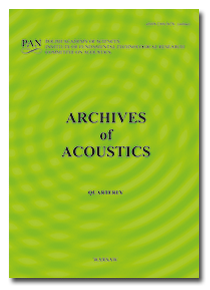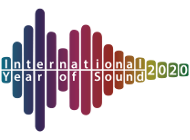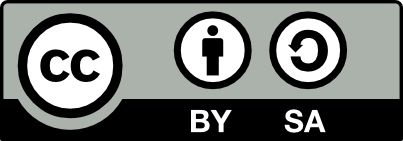10.24425/aoa.2019.129267
Performance Evaluation of T-Shaped Noise Barriers Covered with Oblique Diffusers Using Boundary Element Method
References
Abbasi M., Monnazzam M.R., Zakerian S., Yousefzadeh A. (2015), Effect of wind turbine noise on workers' sleep disorder: a case study of Manjil wind farm in northern Iran, Fluctuation and Noise Letters, 14, 2, 15–20.
Basner M. et al. (2014), Auditory and non-auditory effects of noise on health, The Lancet, 383, 9925, 1325–1332.
Baulac M., Defrance J., Jean P. (2008), Optimisation with genetic algorithm of the acoustic performance of T-shaped noise barriers with a reactive top surface, Applied Acoustics, 69, 4, 332–342.
Brunner D., Junge M., Rapp P., Bebendorf M., Gaul L. (2010), Comparison of the fast multipole method with hierarchical matrices for the Helmholtz-BEM, Computer Modeling in Engineering & Sciences (CMES), 58, 2, 131–160.
EN, C. (2015), Road traffic noise reducing devices – Test method for determining the acoustic performance–Part 4: Intrinsic characteristics – In situ values of sound diffraction, CEN, Brussels, Belgium, SS-EN No: 1793-4.
EN, C. (1998), Road traffic noise reducing devices– Test method for determining the acoustic performance, Part 3: Normalized traffic noise spectrum, CEN, Brussels, Belgium, SS-EN No:1793-3.
Fan R., Su Z., Cheng L. (2013), Modeling, analysis, and validation of an active T-shaped noise barrier, The Journal of the Acoustical Society of America, 134, 3, 1990–2003.
Fard S. M., Kessissoglou N., Samuels S., Burgess M. (2013), Numerical study of noise barrier designs, Proceeding of Acoustics, Victor Harbor, Australia, November 2013.
Garai M. (2004), The new European standard for qualifying added devices, CD-ROM of 18th ICA Kyoto, http://lib.ioa.ac.cn/ScienceDB/18TH-ICA/pdf/Mo5.F.3.pdf.
Garai M., Guidorzi P. (2007), Using CEN/TS 1793-4 to develop an acoustically effective added device for road traffic noise barriers, 19th International Congress on Acoustics, Madrid, http://www.sea-acustica.es/WEB_ICA_07/fchrs/papers/env-06-004.pdf.
Greiner D., Aznárez J.J., Maeso O., Winter G. (2010), Single-and multi-objective shape design of Y-noise barriers using evolutionary computation and boundary elements, Advances in Engineering Software, 41, 2, 368–378.
Halim H., Abdullah R., Ali A.A.A., Nor M.J.M. (2015), Effectiveness of existing noise barriers: comparison between vegetation, concrete hollow block, and panel concrete, Procedia Environmental Sciences, 30, 217–221.
Hothersall D., Crombie D., Chandler-Wilde S. (1991), The performance of T-profile and associated noise barriers, Applied Acoustics, 32, 4, 269–287.
Ishizuka T., Fujiwara K. (2004), Performance of noise barriers with various edge shapes and acoustical conditions, Applied Acoustics, 65, 2, 125–141.
Khoshakhlagh A.H., Ghasemi M. (2017), Occupational Noise Exposure and Hearing Impairment among Spinning Workers in Iran, Iranian Red Crescent Medical Journal, 19, 5, 1–7.
Koussa F., Defrance J., Jean P., Blanc-Benon P. (2013), Acoustic performance of gabions noise barriers: numerical and experimental approaches, Applied Acoustics, 74, 1, 189–197.
May D. N., Osman N. (1980), Highway noise barriers: new shapes, Journal of Sound and Vibration, 71, 1, 73–101.
McNair E.P. (1995), Sound barrier with oblique surfaces, Google Patents.
Monazzam M., Lam Y. (2005), Performance of profiled single noise barriers covered with quadratic residue diffusers, Applied Acoustics, 66, 6, 709–730.
Monazzam M., Lam Y. (2008), Performance of T-shape barriers with top surface covered with absorptive quadratic residue diffusers, Applied Acoustics, 69, 2, 93–109.
Monazzam M., Naderzadeh M., Nassiri P., Fard S. (2010), Performance of environmental T-shape noise barriers covered with primitive root diffusers, Archives of Acoustics, 35, 4, 565–578.
Monazzam M., Nassiri P. (2009), Performance of profiled vertical reflective parallel noise barriers with quadratic residue diffusers, International Journal of Environmental Research, 3, 1, 69–84.
Naderzadeh M., Monazzam M.R., Nassiri P., Fard S.M.B. (2011), Application of perforated sheets to improve the efficiency of reactive profiled noise barriers, Applied Acoustics, 72, 6, 393–398.
Okubo T., Matsumoto T., Yamamoto K., Funahashi O., Nakasaki K. (2010), Efficiency of edge-modified noise barriers: Intrinsic efficiency determination of practical products and prediction of the diffracted sound field, Acoustical Science and Technology, 31, 1, 56–67.
Wang Y., Jiao Y., Chen Z. (2018), Research on the well at the top edge of noise barrier, Applied Acoustics, 133, 118–122.
Wu T., Cox T. J., Lam Y. (2001), A profiled structure with improved low frequency absorption, The Journal of the Acoustical Society of America, 110, 6, 3064–3070.
Yamamoto K. (2015), Japanese experience to reduce road traffic noise by barriers with noise reducing devices, 10th European Congress and Exposition on Noise Control Engineering, EuroNoise 2015, 31 May – 3 June, Maastricht, https://www.conforg.fr/euronoise2015/proceedings/data/articles/000606.pdf.
DOI: 10.24425/aoa.2019.129267






